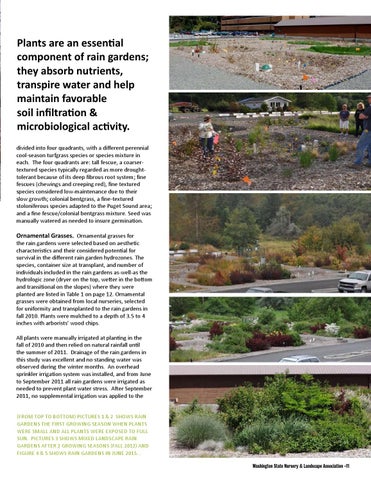Plants are an essential component of rain gardens; they absorb nutrients, transpire water and help maintain favorable soil infiltration & microbiological activity. divided into four quadrants, with a different perennial cool-season turfgrass species or species mixture in each. The four quadrants are: tall fescue, a coarsertextured species typically regarded as more droughttolerant because of its deep fibrous root system; fine fescues (chewings and creeping red), fine textured species considered low-maintenance due to their slow growth; colonial bentgrass, a fine-textured stoloniferous species adapted to the Puget Sound area; and a fine fescue/colonial bentgrass mixture. Seed was manually watered as needed to insure germination.
Ornamental Grasses. Ornamental grasses for the rain gardens were selected based on aesthetic characteristics and their considered potential for survival in the different rain garden hydrozones. The species, container size at transplant, and number of individuals included in the rain gardens as-well-as the hydrologic zone (dryer on the top, wetter in the bottom and transitional on the slopes) where they were planted are listed in Table 1 on page 12. Ornamental grasses were obtained from local nurseries, selected for uniformity and transplanted to the rain gardens in fall 2010. Plants were mulched to a depth of 3.5 to 4 inches with arborists’ wood chips. All plants were manually irrigated at planting in the fall of 2010 and then relied on natural rainfall until the summer of 2011. Drainage of the rain gardens in this study was excellent and no standing water was observed during the winter months. An overhead sprinkler irrigation system was installed, and from June to September 2011 all rain gardens were irrigated as needed to prevent plant water stress. After September 2011, no supplemental irrigation was applied to the (From Top to Bottom) Pictures 1 & 2 shows rain gardens the first growing season when plants were small and all plants were exposed to full sun. Pictures 3 shows mixed landscape rain gardens after 2 growing seasons (fall 2012) and Figure 4 & 5 shows rain gardens in June 2015. . Washington State Nursery & Landscape Association -11
